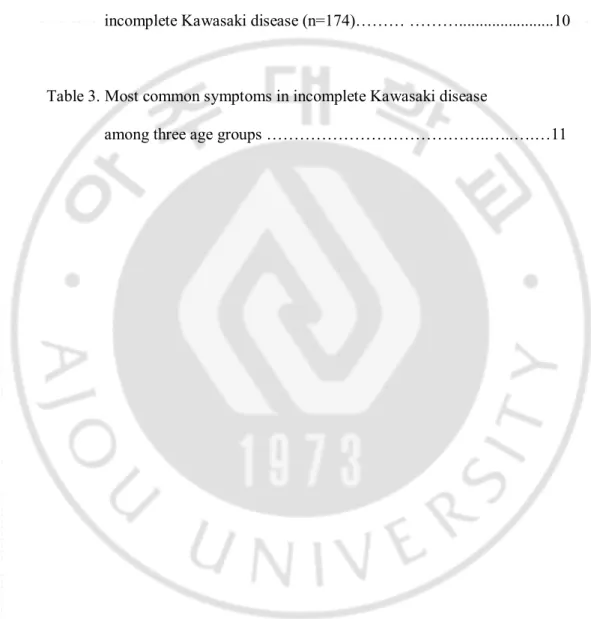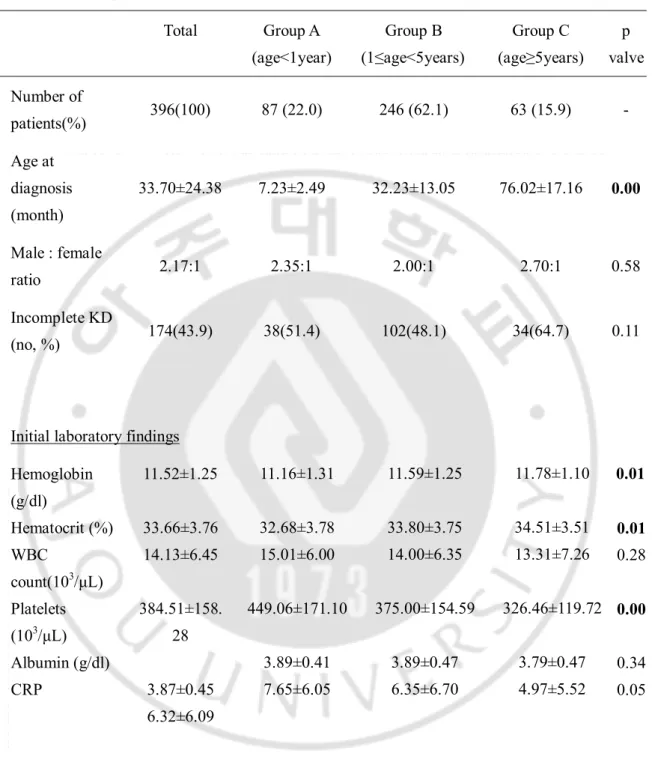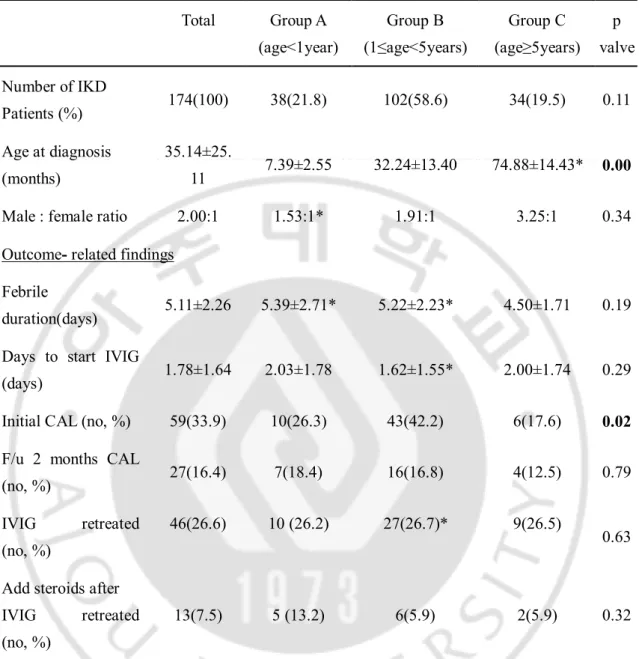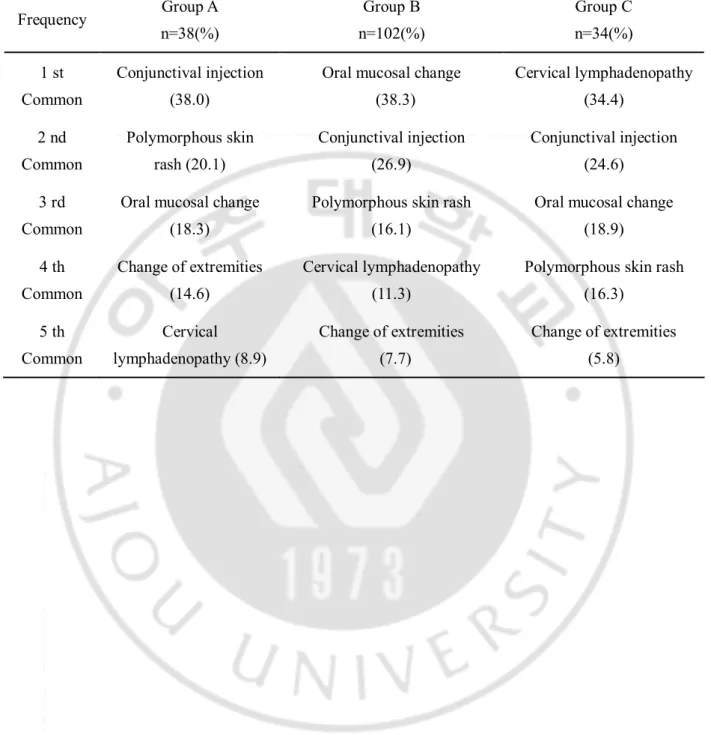저작자표시-비영리-변경금지 2.0 대한민국 이용자는 아래의 조건을 따르는 경우에 한하여 자유롭게 l 이 저작물을 복제, 배포, 전송, 전시, 공연 및 방송할 수 있습니다. 다음과 같은 조건을 따라야 합니다: l 귀하는, 이 저작물의 재이용이나 배포의 경우, 이 저작물에 적용된 이용허락조건 을 명확하게 나타내어야 합니다. l 저작권자로부터 별도의 허가를 받으면 이러한 조건들은 적용되지 않습니다. 저작권법에 따른 이용자의 권리는 위의 내용에 의하여 영향을 받지 않습니다. 이것은 이용허락규약(Legal Code)을 이해하기 쉽게 요약한 것입니다. Disclaimer 저작자표시. 귀하는 원저작자를 표시하여야 합니다. 비영리. 귀하는 이 저작물을 영리 목적으로 이용할 수 없습니다. 변경금지. 귀하는 이 저작물을 개작, 변형 또는 가공할 수 없습니다.
Affect of ‘Age at Diagnosis’
on Coronary Arterial Lesions in Patients
with Incomplete Kawasaki Disease
by
Min A Cho
Major in Medicine
Department of Medical Sciences
The Graduate School, Ajou University
Affect of ‘Age at Diagnosis’
on Coronary Arterial Lesions in Patients
with Incomplete Kawasaki Disease
by
Min A Cho
A Dissertation Submitted to The Graduate School of Ajou University
in Partial Fulfillment of the Requirements for the Degree of
Master of Medicine
Supervised by
Jo Won Jung, M.D., Ph.D.
Major in Medicine
Department of Medical Sciences
The Graduate School, Ajou University
This certifies that the dissertation
of Min A Cho is approved.
SUPERVISORY COMMITTEE
Jo Won Jung
Ki Soo Pai
Jin Soon Hwang
The Graduate School, Ajou University
June, 25th, 2010
i
- ABSTRACT –
Affect of ‘Age at Diagnosis’ on Coronary Arterial Lesions
in Patients with Incomplete Kawasaki Disease
Backgroud: Diagnosis of Kawasaki disease (KD) is based on 5 clinical features. Incomplete
KD (IKD) with a fewer features is more common in infants and older children, in whom the rate of coronary artery aneurysms is paradoxically higher. This study was designed to evaluate between the age at diagnosis and the risk factors on coronary arterial lesions (CAL) in patients with IKD.
Methods: Data from 396 patients with KD in single center were collected from January
2003 to July 2007 retrospectively. Patients were grouped according to their age at diagnosis; Group A (<1 year of age), Group B (1≤age<5 years of age), and Group C (≥5 years of age).
Results: In total of 396 patients with KD, 87 (22.0%) patients were in Group A, 246 (62.1%)
in Group B, and 63 (15.9%) in Group C. In groups A and C, days to start intravenous immunoglobulin (IVIG) were longer than Group B. There were no differences in the incidence of IKD, the late CAL, and the rate of IVIG retreatment among three groups. In 174 patients with IKD, there were no differences in the late incidence of CAL and IVIG retreatment according to different age groups either. Compared with typical KD, the febrile duration and days to start IVIG were longer, and the rate of IVIG retreatment was higher in IKD, but there was no difference in the risk of CAL between the typical and IKD.
Conclusions: Recently in the management of KD, especially the incomplete type, the age at
KD diagnosis may be no more significant to determine the development of CAL.
KEY WORDS: Mucocutaneous lymph node syndrome; Coronary arterial lesions;
ii
TABLE OF CONTENTS
ABSTRACT………...……….i
TABLE OF CONTENTS………..….………..….… ii
LIST OF TABLES………..………...……….….… iii
Ⅰ. INTRODUCTION ………..… 1
Ⅱ. MATERIALS AND METHODS…….………....……….…...2
Ⅲ. RESULTS………..………...4
Ⅳ. DISCUSSION………...12
Ⅴ. CONCLUSION……….………...15
REFERENCES……….…….……….………….…..16
iii
LIST OF TABLES
Table 1. Demographic features, initial laboratory and outcome- related
findings among three age groupswith Kawasaki disease (N=396)...6
Table 2. Clinical features and outcome among three age groupswith
incomplete Kawasaki disease (n=174)……… ………...10
Table 3. Most common symptoms in incomplete Kawasaki disease
- 1 -
I. INTRODUCTION
Kawasaki disease (KD) is an acute febrile vasculitis of unknown etiology. It is a major cause of pediatric acquired heart diseases in Asia including South Korea (
Melish, 1996;
Laupland and Davies, 1999; Rowley and Shulman 1999).
In the epidemiologic studies of KD in Korea from 2003 to 2005, it predominantly occurred in children under 5 years of age with a proportion of 87.7%. The peak age of onset was 6–12 months of age with the highest frequency of 13.9% (
Park et al, 2007).
For children in the acute phase of KD, treatment with intravenous immunoglobulin (IVIG) and aspirin has been still recommended by American heart Association (AHA). Approximately 15% to 25% of untreated children develop coronary artery aneurysms or ectasia, but treatment with IVIG in the acute phase reduces this risk below 5% (
Newburger
et al, 2004).
Diagnosis of KD is based on 5 clinical features, and it can be difficult to diagnose because there is no diagnostic laboratory test. Some patients who don't fulfill the criteria have been diagnosed as having "incomplete" KD, more frequently in infant and children older than 5 years of age, and diagnosis of KD might be delayed because of a fewer clinical features and leading to increased incidence of coronary complications(
Kawasaki,1967; Elaine,1995; Yanagawa et al, 2001; Ayusawa et al, 2005;
Fukazawa and Ogawa, 2009)
In the present study, we attempted to evaluate and compare the prevalence, clinical features and time to start intravenous immunoglobulin (IVIG), and outcomes among different age groups, and to analyze the age-associated risk factors on coronary arterial lesions in patients with incomplete KD.
- 2 -
II. MATERIALS AND METHODS
The charts of 396 inpatients diagnosed with KD at Ajou University Hospital from January 2003 to July 2007 were reviewed retrospectively.
Clinical profiles, initial laboratory data, echocardiographic findings, therapeutics and follow-up data in patients with KD were collected from each medical record. According to patient’s age, these patients were divided into 3 groups: infant (Group A), children under 5 years of age (Group B), children 5 years-old or older (Group C).
Diagnosis of KD was based on clinical features by the revised criteria of AHA, which included fever for at least 4 days and additional four of the following five signs: bilateral conjunctival injections; oral mucosal changes, such as injected pharynx, dry cracked lips, or strawberry tongue; changes of hands and feet, such as redness and swelling in the acute phase, and periungual desquamation in the subacute phase; rash, primarily on the trunk, that may be maculopapular, or erythema multiforme; and cervical lymph node greater than 1.5 cm in diameter (
Newburger et al, 2004; Ayusawa et al, 2005)
. Even if the aforementioned clinical criteria were not satisfied, the patients with dilatation or aneurysm of the coronary artery on echocardiography, were included. Diagnosis of incomplete KD was defined as unexplained fever for ≥4 days associated with 2 or 3 of the principal clinical features, or as unexplained fever for only a few days with typical 4 symptoms listed above, and exclusively other diseases(Ayusawa et al, 2005)
.Echocardiograms were usually repeated on admission and 2- months after the first echocardiogram, and thereafter whenever thought necessary. Normal ranges for coronary artery size defined according to the age was used following the criteria of AHA (
Newburger
- 3 -
et al, 2004)
. These criteria of echocardiographic measurements of coronary arteries classified as abnormal when the internal lumen diameter is ≥3 mm in children younger than 5 years of age or ≥4 mm in children aged 5 years or more, when the internal diameter of any segment measures at least 1.5 times that of an adjacent segment, or when the coronary artery lumen is clearly irregular(Yanagawa et al, 2001)
.The mean and, standard deviation (SD), and range were calculated for all of the descriptive variables. Nominal data were analyzed using the χ2 test. Continuous variables
were compared using the ANOVA test. p<0.05 was considered statistically significant. Analyses were performed using SPSS 13.0 (SPSS Inc, Chicago, IL, US).
- 4 -
III. RESULTS
1. Demographic characteristics and initial laboratory findings
Total numbers of 396 patients with KD were analyzed, and there were 174 patients with incomplete type. The clinical profiles for the three groups were shown in Table 1. Number of male patients as 271 (69%) was more than that of female as 125 (31%) and the male-to-female ratio was 2.17:1. The mean age at diagnosis was 33.70 ± 24.38 months of age (range: 2 months~12 years of age).
Eighty-seven (22.0%) children were in Group A, 246 (62.1%) in Group B, and 63 (15.9%) in Group C. The mean age of each group was 7.23 ± 2.49 months in Group A, 32.23 ± 13.05 months in Group B, and 76.02 ± 17.16 months in Group C. Group A had significantly higher platelet counts and lower hemoglobin values than other groups.
Incomplete KD (n=174) was 43.9% of total patients (n=396), with 38 (51.4%) of Group A, 102(48.1%) of Group B, and 34(64.7%) of Group C. In Group A and C, relatively higher proportions with incomplete type were shown than Group B (p=0.11).
2. Response for treatment and development of coronary arterial lesions
Every patient with KD received a high-dose IVIG treatment or more. The mean duration to start IVIG after admission were significantly longer as in Group A and Group C (1.85 ± 1.78 days and 1.91 ± 1.69 days, respectively) than in Group B (1.43 ± 1.26 days). At initial findings of echocardiography, there was higher incidence of CAL as 103 patients (41.9%) in Group B. After 2 months, there were no significant differences among 3 groups.
- 5 -
In the necessity for IVIG retreatment or additional dexamethasones, there were no significant differences among 3 groups (Table 1).
- 6 -
Table 1. Demographic features, initial laboratory and outcome- related findings among three age groupswith Kawasaki disease (N=396)
Total Group A (age<1year) Group B (1≤age<5years) Group C (age≥5years) p valve Number of patients(%) 396(100) 87 (22.0) 246 (62.1) 63 (15.9) - Age at diagnosis (month) 33.70±24.38 7.23±2.49 32.23±13.05 76.02±17.16 0.00 Male : female ratio 2.17:1 2.35:1 2.00:1 2.70:1 0.58 Incomplete KD (no, %) 174(43.9) 38(51.4) 102(48.1) 34(64.7) 0.11
Initial laboratory findings Hemoglobin (g/dl) Hematocrit (%) WBC count(103/μL) Platelets (103/μL) Albumin (g/dl) CRP 11.52±1.25 33.66±3.76 14.13±6.45 384.51±158. 28 3.87±0.45 6.32±6.09 11.16±1.31 32.68±3.78 15.01±6.00 449.06±171.10 3.89±0.41 7.65±6.05 11.59±1.25 33.80±3.75 14.00±6.35 375.00±154.59 3.89±0.47 6.35±6.70 11.78±1.10 34.51±3.51 13.31±7.26 326.46±119.72 3.79±0.47 4.97±5.52 0.01 0.01 0.28 0.00 0.34 0.05
- 7 - Outcome- related findings
Febrile duration(days) 4.88±2.03 4.80±2.39 4.92±1.94 4.83±1.90 0.88 Days to start IVIG (days) 1.60±1.47 1.85±1.78 1.43±1.26 1.91±1.69 0.03 Initial CAL (no, %) 136(34.3) 25(28.7) 103(41.9) 8(12.7) 0.00 F/u 2 mo CAL (no, %) 44(11.1) 10(11.8) 30(12.9) 4(6.6) 0.39 IVIG retreated (no, %) 90(22.7) 16 (21.7) 65(30.8) 9(16.9) 0.32 Add steroids after IVIG retreated (no, %) 28(7.1) 8 (10.8) 16(7.5) 4(7.5) 0.67
Abbreviations: KD; Kawasaki disease, WBC; white blood cell, CRP; C-reactive protein, IVIG; intravenous immunoglobulin, CAL; coronary arterial lesion.
- 8 -
3. Clinical features and outcomes in patients with incomplete KD
The comparisons of clinical features among 3 groups with incomplete KD are shown in Table 2. The male-to-female ratio was 2.0:1. The mean age at diagnosis was 35.14 ± 25.11 months.
The durations to start IVIG after admission were relatively longer in Group A and Group C than Group B (p=0.29). In the febrile duration, however, there were no differences among 3 groups.
At initial findings of echocardiography, there was higher incidence of CAL as 43 patients (42.2%) in Group B. After 2 months, there were no significant differences among 3 groups. In the need for IVIG retreatment or additional dexamethasones, there was no significant difference among 3 groups (Table 2).
In aspects of common clinical features, comparisons among 3 groups with incomplete KD are described in Table 3. Most common symptoms in 3 groups with incomplete KD were bilateral conjunctival injection (38% in Group A), red lip/oral mucosal changes (38.3% in Group B), and cervical lymphadenopathy (34.4% in Group C).
4. Comparison of clinical features and outcomes between patients with the typical KD and those with incomplete type according to different age groups
Compared with the typical type, the duration of fever was longer in Group A with incomplete type, but in other parameters, there were no significant differences.
- 9 -
In Group B with incomplete KD, the febrile duration and days to start IVIG after admission were longer and the rate of IVIG retreatment higher than those with typical type. In aspects of CAL, there were no differences between two groups (Table 2).
- 10 -
Table 2. Clinical features and outcome among three age groups with incomplete Kawasaki disease (n=174) Total Group A (age<1year) Group B (1≤age<5years) Group C (age≥5years) p valve Number of IKD Patients (%) 174(100) 38(21.8) 102(58.6) 34(19.5) 0.11 Age at diagnosis (months) 35.14±25. 11 7.39±2.55 32.24±13.40 74.88±14.43* 0.00 Male : female ratio 2.00:1 1.53:1* 1.91:1 3.25:1 0.34 Outcome- related findings
Febrile
duration(days) 5.11±2.26 5.39±2.71* 5.22±2.23* 4.50±1.71 0.19 Days to start IVIG
(days) 1.78±1.64 2.03±1.78 1.62±1.55* 2.00±1.74 0.29 Initial CAL (no, %) 59(33.9) 10(26.3) 43(42.2) 6(17.6) 0.02
F/u 2 months CAL
(no, %) 27(16.4) 7(18.4) 16(16.8) 4(12.5) 0.79 IVIG retreated
(no, %)
46(26.6) 10 (26.2) 27(26.7)* 9(26.5)
0.63 Add steroids after
IVIG retreated (no, %)
13(7.5) 5 (13.2) 6(5.9) 2(5.9) 0.32
Abbreviations: IKD; incomplete Kawasaki disease, WBC; white blood cell, CRP; C-reactive protein, IVIG; intravenous immunoglobulin, CAL; coronary arterial lesion.
Mean ± standard deviation
- 11 -
Table 3. Most common symptoms in incomplete Kawasaki disease among three age groups Frequency Group A n=38(%) Group B n=102(%) Group C n=34(%) 1 st Common Conjunctival injection (38.0)
Oral mucosal change (38.3) Cervical lymphadenopathy (34.4) 2 nd Common Polymorphous skin rash (20.1) Conjunctival injection (26.9) Conjunctival injection (24.6) 3 rd Common
Oral mucosal change (18.3)
Polymorphous skin rash (16.1)
Oral mucosal change (18.9) 4 th Common Change of extremities (14.6) Cervical lymphadenopathy (11.3)
Polymorphous skin rash (16.3) 5 th Common Cervical lymphadenopathy (8.9) Change of extremities (7.7) Change of extremities (5.8)
- 12 -
IV. DISCUSSION
Kawasaki disease is an acute febrile vasculitis of unknown causes commonly affected in children under 5 years of age. Since first reported by Tomisaku Kawasaki in 1967, it’sthe most common acquired cardiovascular disease in pediatric age (
Kawasaki, 1967)
. In 1984 Furusho et al. had reported the effects of IVIG therapy on KD, and the occurrence of CAL and its mortality was significant reduced(Furusho
.et al, 1984).However, whereas children with the typical KD are immediately diagnosed and given IVIG treatment after admission, children with incomplete KD are difficult to distinguish from other infectious diseases and to find out clear diagnostic criteria, often resulting in delayed treatments (
Rowley and Shulman, 1998).
There were a greater time interval from meeting the diagnostic criteria to making the diagnosis and a higher proportion of CAL in infants under 1 year of age and children over 5 years of age compared with children 1 to 5 years of age(Kato et al, 1975; Hsiao
.et al, 1998;Fan et al, 2003
).Kawasaki Disease Research Committee published revised diagnostic criteria in 2002 (
Newburger et al, 2004; Ayusawa et al, 2005)
. Major alterations are interpretation of cases with 4 or fewer febrile days shortened by early IVIG treatment and the importance of incomplete KD. Then, AHA published the latest diagnostic criteria and the importance of incomplete KD was emphasized in this guide. The conventional diagnostic criteria should be viewed as guidelines that are particularly useful in preventing overdiagnosis but may result in failure to recognize incomplete forms of illness. In the present study according to revised guideline of AHA, children under the age of 1 year and over 5 years with incomplete KD revealed higher incidence as 51.4% and 64.7% compared with 22.0% and 15.9% in the same- 13 -
age groups with each type. Moreover, days to start IVIG treatment after admission were significantly longer in both groups than in children 1 to 5 years of age. Since there was a possibility of delayed treatment in both groups, the risk of CAL accompanying with incomplete KD might be increased. In this study, however, there was no significant difference among the 3 groups with incomplete type or not.
Even though the patient had a few symptoms indicating incomplete KD, its early diagnosis could be done through the common clinical manifestations distinguished among 3 groups divided by age.
Hsiao et al reported that patients less than 6 months of age with oral lesions or hard swelling of the palms or feet, were rare. Typical mucosal changes and the lymph nodes in patients with less than 6 months of age were less likely (
Hsiao et al, 1998)
. Fan et al. reported that cervical lymph node enlargement appeared in most school children with KD, who were diagnosed early as acute purulent lymph nodes and treated with antibiotic treatment(Fan et al, 2003)
. In our study on incomplete KD, bilateral conjunctival injection was the most common presentation of diagnostic criteria in infants and cervical lymphadenopathy in patients older than 5 years of age.Recent studies of the vascular function focus on the endothelial dysfunction and the progressive atherosclerosis after the onset of KD, and suggest that there were no significant differences between normal coronary arteries of well-treated KD patients and healthy people
(
Yanagawa et al, 2001; Cheung et al, 2008; Lee, 2009)
. Even in KD patients with goodresponses to IVIG, CAL still occasionally occurred (
Nakamura et al, 1991; Han, 2000;
Cho et al, 2001; Lee, 2001)
. High echodensity of the coronary arterial wall was demonstrated at a mean of 5.4 days from onset. Without IVIG therapy, diffuse coronary- 14 -
arterial dilatation was observed in 50% of KD patients at about 9.5 days, diffuse coronary artery dilatation progresses to aneurysms in 28.8% at 11.4 days, and resolution of coronary arterial dilatation within 30 days from onset in stage of transient dilation. CALs that persist beyond 30 days from onset might be considered as KD sequelae (Kato et al, 1975;
Nakamura et al, 1991).
CALs of small to medium size are likely to regress within 1 to 2 years and still remain in 3~7% after onset of KD(Kato et al, 1975;Han, 2000; Lee, 2001).
- 15 -
V. CONCLUSION
As for this study, children older than 5 years of age as well as those younger than 1 year of age had a higher percentage of incomplete KD, and there were no significant differences in the clinical outcome whether retreatment was needed or not and in the existence of advanced development of late CAL. Prolonged fever without any definite focus with conjunctival injection in children younger than 1 year of age and cervical lymphadenopathy in children older than 5 years of age should be considered as KD. Recently in the management of KD, especially incomplete type, age at KD diagnosis may be no more significant to determine the development of CAL.
- 16 -
REFERENCE
1. Ayusawa M, Sonobe T, Uemura S, Ogawa S, Nakamura Y, Kiyosawa N, Ishii M, Harada K; Kawasaki Disease Research Committee: Revision of diagnostic guidelines for Kawasaki disease(the 5th revised edition). Pediatr Int 47:232-234, 2005
2. Cheung YF, O K, Woo CW, Armstrong S, Siow YL, Chow PC, Cheung EW: Oxidative stress in children late after Kawasaki disease: relationship with carotid atherosclerosis and stiffness. BMC Pediatr 8:20, 2008
3. Cho HJ, Yu JJ, Kim HS: The detection of acute phase Kawasaki myocarditis via echocardiographic functional studies. Korean Circ J 31:1318-1323, 2001
4. Elaine AR, Kathleen EC, Stanford TS: Kawasaki disease in infants less than one year of age. J Pediatr 126:524-529, 1995
5. Fan PC, Chiu CH, Yen MH, Huang YC, Li CC, Lin TY: School-aged children with Kawasaki disease: high incidence of cervical lymphadenopathy and coronary artery involvement. J Paediatr Child Health 39:55-57, 2003
6. Fukazawa R, Ogawa S: Long-term prognosis of patients with Kawasaki disease: at risk for future atherosclerosis? J Nippon Med Sch 76: 124-133, 2009
7. Furusho K, Kamiya T, Nakano H, Kiyosawa N, Shinomiya K, Hayashidera T, Tamura T, Hirose O, Manabe Y, Yokoyama T, et al: High dose intravenous gammaglobulin for Kawasaki disease. Lancet 2:1055-1058, 1984
- 17 -
8. Han RK, Sinclair B, Newman A, Silverman ED, Taylor GW, Walsh P, McCrindle BW: Recognition and management of Kawasaki disease. CMAJ 162(6):807-812, 2000 9. Hsiao JY, Chen MR, Huang FU, Kao HA, Sung TC: Clinical analysis of Kawasaki
disease in infants below 6 months of age. Acta Paediatr Sin 29:318-323, 1998
10. Kato H, Koike S, Yamamoto M, Ito Y, Yano E: Coronary aneurysm in infants and young children with mucocutaneous lymph node syndrome. J Pediatr 86:892-898, 1975 11. Kawasaki T. Acute febrile mucocutaneous syndrome with lymphoid involvement with specific desquamation of the fingers and toes in children. Jpn J Allergy 16:178-222, 1967.
12. Laupland KB, Davies HD: Epidemiology, etiology, and management of Kawasaki disease: state of the art. Pediatr Cardiol 20: 177–183, 1999
13. Lee SJ, Ahn HM, You JH, Hong YM: carotid intima-media thickness and pulse wave velocity after recovery from Kawasaki disease. Korean Circ J 39:264-269, 2009
14. Lee SY, Gwon HC, Park SW, Kim JS, Kim DK, Lee SH, Kyung-Pyo Hong KP,Park JE, Seo JD, Lee WR: Acute myocardial infarction in young patient probably due to Kawasaki disease. Korean Circ J 2001;31:119-124, 2001
15. Melish ME: Kawasaki syndrome. Pediatr Rev 17: 153–162, 1996
16. Nakamura Y, Fujita Y, Nagai M: Cardiac sequelae of Kawasaki disease in Japan : statistical analysis. Pediatrics 88:1144-1147, 1991
- 18 -
17. Newburger JW, Takahashi M, Gerber MA, Gewitz MH, Tani LY, Burns JC, Shulman ST, Bolger AF, Ferrieri P, Baltimore RS, Wilson WR, Baddour LM, Levison ME, Pallasch TJ, Falace DA, Taubert KA; Committee on Rheumatic Fever, Endocarditis and Kawasaki Disease; Council on Cardiovascular Disease in the Young; American Heart Association; American Academy of Pediatrics: Diagnosis, treatment, and long-term management of Kawasaki disease: a statement for health professionals from the Committee on Rheumatic Fever, Endocarditis and Kawasaki Disease, Council on Cardiovascular Disease in the Young, American Heart Association. Circulation 110(17):2747–2771, 2004
18. Park YW, Han JW, Park IS, Kim CH, Cha SH, Ma JS, Lee JS, Kwon TC, Lee SB, Kim CH, Lee HJ, Yun YS: Kawasaki disease in Korea, 2003-2005. Pediatr Infect Dis J 26:821-823, 2007
19. Rowley AH, Shulman ST: Kawasaki syndrome. Pediatr Clin North Am 46: 313–329, 1999
20. Shulman ST, Rowley AH: Advances in Kawasaki disease. Eur J Pediat. 163(6):285-291, 2004
21. Yanagawa H, Nakamura Y, Yashiro M, Oki I, Hirata S, Zhang T, Kawasaki T: Incidence survey of Kawasaki disease in 1997 and 1998 in Japan. Pediatrics 107:E33, 2001
- 19 - - 국문요약 –
불완전 가와사끼병을 가진 환아에서 진단 당시의 연령이
관상동맥 병변에 미치는 영향
아주대학교 대학원의학과 조 민 아 (지도교수: 정 조 원 ) 배경: 가와사키병의 진단은 5 개의 임상적 특징에 근거를 두고 있다. 불완전 가와사키병은 유아 및 좀더 연령이 많은 소아에서 흔하며, 이보다 더 적은 개수의 임상적인 특징을 보일 때 진단이 되지만, 상대적으로 관상동맥류의 발생률은 오히려 더 높다. 이에 불완전 가와사끼병을 가진 환아에서 관상 동맥 병변과 진단 당시 나이에 대해 위험 요인을 평가하기 위해 본 연구를 하고자 한다. 방법: 2003 년 1 월부터 2007 년 7 월까지 단일병원에 입원하여 가와사끼병으로 진단받은 환자 396 명에서 후향적으로 의무기록을 검색하였다. 환자는 진단 당시의 나이에 3 군으로 분류하였다. ; A 군 (< 1 세), B 군(1 ≤ 나이 <5 세), 그리고 C 군(≥ 5 세). 결과: 가와사끼병을 가진 환아 총 396 명에서 A 군은 87 명(22.0 %), B 군은- 20 - 246 명(62.1 %), 그리고 C 군은 63 명(15.9 %)이었다. A 군과 C 군에서 볼 때 진단되어 정맥용 면역글로불린 주사 투여 까지의 기간이 B 군에 비하여 유의하게 더 길었으나 , 세 군 사이에 추적 관상동맥병변의 발생빈도 및 정맥용 면역글로블린 주사의 재치료율에 있어 유의한 차이가 없었다. 174 명의 환아에서 불완전 가와사끼병으로 진단되었으며, 나이가 다른 각각 세 군간에 관상동맥병변의 발생빈도 및 정맥용 면역글로블린주사 재치료율에 있어 유의한 차이가 없었다. 전형적인 가와사끼병과 비교하여 볼 때 열 나는 총 기간 및 진단된어 정맥용 면역 글로블린 주사를 투여하기 까지의 기간은 불완전 가와사끼병을 가진 환아에서 보다 더 길었고, 정맥용 면역 글로블린 주사의 재치료율도 불완전 가와사끼병을 가진 환아에서 더 높았으나, 관상동맥 병변의 발생 위험도에서 두 군간에 별 차이가 없었다. 결론 : 최근 가와사끼병의 치료, 특히 불완전 가와사끼병에서는 진단시 나이는 더 이상 관상 동맥 병변 진행에는 그리 중요하지 않다. 핵심어 : 가와사끼병 ; 관상동맥 병변; 불완전 가와사끼병



